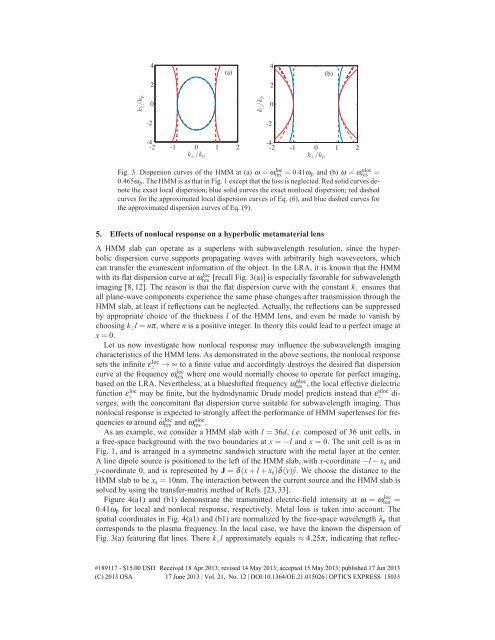Download PDF - Optics InfoBase
Download PDF - Optics InfoBase
Download PDF - Optics InfoBase
Create successful ePaper yourself
Turn your PDF publications into a flip-book with our unique Google optimized e-Paper software.
Fig. 3. Dispersion curves of the HMM at (a) ω = ωres loc = 0.41ω p and (b) ω = ωres nloc =<br />
0.465ω p . The HMM is as that in Fig. 1 except that the loss is neglected. Red solid curves denote<br />
the exact local dispersion, blue solid curves the exact nonlocal dispersion; red dashed<br />
curves for the approximated local dispersion curves of Eq. (6), and blue dashed curves for<br />
the approximated dispersion curves of Eq. (9).<br />
5. Effects of nonlocal response on a hyperbolic metamaterial lens<br />
A HMM slab can operate as a superlens with subwavelength resolution, since the hyperbolic<br />
dispersion curve supports propagating waves with arbitrarily high wavevectors, which<br />
can transfer the evanescent information of the object. In the LRA, it is known that the HMM<br />
with its flat dispersion curve at ωres loc [recall Fig. 3(a)] is especially favorable for subwavelength<br />
imaging [8, 12]. The reason is that the flat dispersion curve with the constant k ⊥ ensures that<br />
all plane-wave components experience the same phase changes after transmission through the<br />
HMM slab, at least if reflections can be neglected. Actually, the reflections can be suppressed<br />
by appropriate choice of the thickness l of the HMM lens, and even be made to vanish by<br />
choosing k ⊥ l = nπ, where n is a positive integer. In theory this could lead to a perfect image at<br />
x = 0.<br />
Let us now investigate how nonlocal response may influence the subwavelength imaging<br />
characteristics of the HMM lens. As demonstrated in the above sections, the nonlocal response<br />
sets the infinite ε loc<br />
⊥<br />
→ ∞ to a finite value and accordingly destroys the desired flat dispersion<br />
curve at the frequency ωres loc where one would normally choose to operate for perfect imaging,<br />
based on the LRA. Nevertheless, at a blueshifted frequency ωres nloc , the local effective dielectric<br />
function ε loc<br />
⊥<br />
may be finite, but the hydrodynamic Drude model predicts instead that ε nloc<br />
⊥<br />
diverges,<br />
with the concomitant flat dispersion curve suitable for subwavelength imaging. Thus<br />
nonlocal response is expected to strongly affect the performance of HMM superlenses for frequencies<br />
ω around ωres loc and ωres nloc .<br />
As an example, we consider a HMM slab with l = 36d, i.e. composed of 36 unit cells, in<br />
a free-space background with the two boundaries at x = −l and x = 0. The unit cell is as in<br />
Fig. 1, and is arranged in a symmetric sandwich structure with the metal layer at the center.<br />
A line dipole source is positioned to the left of the HMM slab, with x-coordinate −l − x s and<br />
y-coordinate 0, and is represented by J = δ(x + l + x s )δ(y)ŷ. We choose the distance to the<br />
HMM slab to be x s = 10nm. The interaction between the current source and the HMM slab is<br />
solved by using the transfer-matrix method of Refs. [23, 33].<br />
Figure 4(a1) and (b1) demonstrate the transmitted electric-field intensity at ω = ωres loc =<br />
0.41ω p for local and nonlocal response, respectively. Metal loss is taken into account. The<br />
spatial coordinates in Fig. 4(a1) and (b1) are normalized by the free-space wavelength λ p that<br />
corresponds to the plasma frequency. In the local case, we have the known the dispersion of<br />
Fig. 3(a) featuring flat lines. There k ⊥ l approximately equals ≈ 4.25π, indicating that reflec-<br />
#189117 - $15.00 USD Received 18 Apr 2013; revised 14 May 2013; accepted 15 May 2013; published 17 Jun 2013<br />
(C) 2013 OSA 17 June 2013 | Vol. 21, No. 12 | DOI:10.1364/OE.21.015026 | OPTICS EXPRESS 15033
















